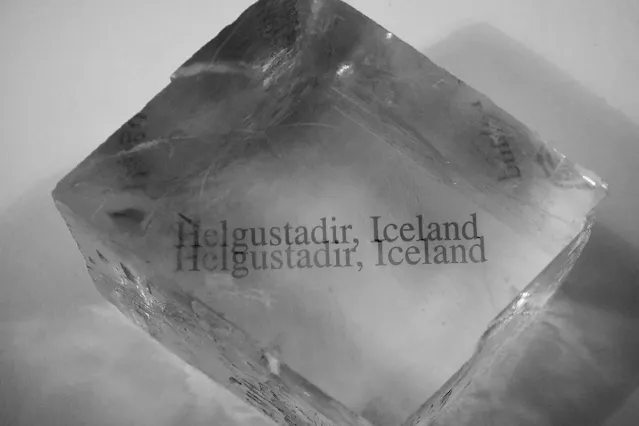Iceland Spar: Optical Calcite
Iceland spar, also known as optical calcite, is a transparent variety of the mineral calcite, which is a naturally occurring calcium carbonate. It holds a special place in optics and mineralogy due to its unique property of double refraction.
Iceland Spar is a remarkable form of calcite, a crystalline mineral known for its double refraction phenomenon. When light passes through Iceland Spar, it splits into two separate rays, creating a captivating visual effect.
This unique property earned Iceland Spar its nickname "Viking Crystal," as it is said that ancient Norse seafarers used these crystals as navigation aids, especially in overcast conditions when the sky's polarization was less discernible.
It occurs in large readily cleavable crystals, easily divisible into rhombs, and is remarkable for its birefringence. This means that the index of refraction of the crystal is different for light of different polarization. A ray of unpolarized light passing through the crystal divides into two rays of perpendicular polarization directed at different angles, called double refraction. So objects seen through the crystal appear doubled.
Formation of Iceland Spar
The origins of Iceland Spar are deeply embedded in the Earth's geological history. This gemstone is primarily formed from calcite minerals that crystallize under specific temperature and pressure conditions. It can be found in various locations around the world, but the finest and most well-known deposits are found in Iceland, where the gemstone derives its name. Iceland Spar often forms as transparent rhombohedral crystals, showcasing its optical properties to their fullest extent.
Properties of Iceland Spar
Iceland spar is a transparent crystal with a refractive index of 1.658. This means that it bends light more than most other transparent materials. Iceland spar also has a high birefringence, which is the difference in refractive index between two perpendicular polarizations of light. This property causes objects seen through Iceland spar to appear doubled.
 |
| Researchers say this crystal found at the Alderney shipwreck near the Channel Islands could prove fabled Viking sunstones really did exist. |
How did Iceland Spar help the Vikings?
Researchers studied a piece of Iceland spar discovered aboard an Elizabethan ship that sunk in 1592. They found that moving the stone in and out of a person's field of vision causes them to see a distinctive double dot pattern that lines up with the direction of the hidden Sun.
 |
| Screenshot from the TV show Viking |
The polarization of sunlight in the Arctic can be detected, and the direction of the sun identified to within a few degrees in both cloudy and twilight conditions using the sunstone and the naked eye. The process involves moving the stone across the visual field to reveal a yellow entoptic pattern on the fovea of the eye, probably Haidinger's brush.
When light passes through calcite crystals, it is split into two rays. The asymmetry in the crystal's structure causes the paths of these two beams to be bent by different amounts, resulting in a double image.
 |
| Iceland Spar, Rhombus Optical Calcite |
Uses and Applications
Beyond its fascinating optical behavior, Iceland spar boasts a rich history and diverse applications across various fields. Let's delve into its remarkable uses and applications:
1. Scientific and Technical Instruments:
- Polarizing Microscopes: Iceland spar plays a crucial role in polarizing microscopes, enabling scientists to study the birefringent properties of materials like minerals, gemstones, and biological samples. This allows for detailed analysis of their structure and composition.
- Nicol Prisms: These prisms, crafted from Iceland spar, are vital components of various optical instruments, including polarimeters, spectrophotometers, and microscopes. They utilize double refraction to isolate specific light polarizations, crucial for scientific measurements and analysis.
- Calcite Filters: Iceland spar filters, based on its birefringence, find applications in cameras and medical imaging systems. They control the polarization of light, enhancing image quality and enabling specific imaging techniques.
 |
| Natural polished "Iceland Spar" (or) Optical Calcite |
2. Decorative Objects and Jewelry
- Polished Crystals: Iceland spar's natural beauty shines through when polished, revealing stunning internal patterns and clarity. These crystals are prized by collectors and incorporated into decorative objects, adding a touch of elegance and intrigue to any space.
- Faceted Gems: When faceted, Iceland spar transforms into captivating gemstones, showcasing its unique optical effects and captivating colors. These gems are prized by jewelry designers and collectors for their distinctive beauty.
3. Historical Significance:
- Viking Navigation: The Vikings are believed to have used Iceland spar for navigation on cloudy days. Its double refraction property helped them locate the sun's position, aiding them in their voyages.
- Understanding Light: Iceland spar played a pivotal role in the early understanding of light. Its double refraction phenomenon challenged the wave theory of light and paved the way for advancements in optics and our modern understanding of light behavior.
 |
| Iceland Spar: Optical Calcite |
Caring for Iceland Spar
To maintain the pristine beauty of Iceland Spar, proper care is essential. Avoid exposing the crystal to direct sunlight for extended periods, as excessive UV exposure may alter its color. Gently clean Iceland Spar using a soft, damp cloth to remove dust and debris, and store it away from other harder gemstones to prevent scratching.
 |
| Polished Optical Calcite Rhomb from Brazil |

